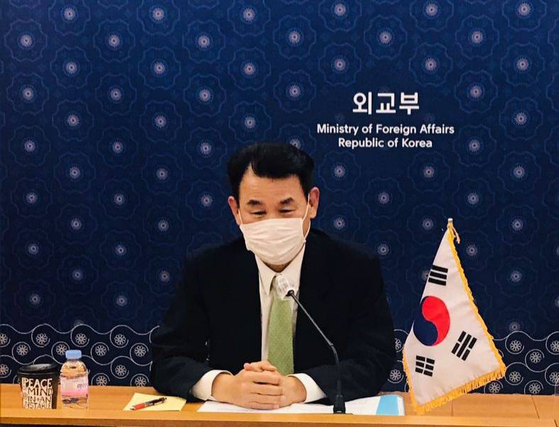The ROK-US is ahead of the conclusion of the 11th Special Agreement on Defense Expense Shares (SMA). An analysis suggests that it is necessary to carefully look at the gains and losses as the ‘13% increase’, which was agreed at last year’s working line but fell at the last minute against the opposition of former President Donald Trump.
![Eun-bo Chung, Ambassador of Korea-US Defense Cost Sharing Negotiations [외교부]](https://i0.wp.com/pds.joins.com/news/component/htmlphoto_mmdata/202102/15/363f3171-c3e5-49a4-bc1b-622a7fa43e34.jpg?w=560&ssl=1)
Eun-bo Chung, Ambassador of Korea-US Defense Cost Sharing Negotiations [외교부]
① What is the annual increase rate?
The defense cost-sharing agreement is currently being discussed. In the case of a’multi-year contract’, not only the rate of increase in the first year but also how much each year from the following year is a major variableAll. Until the 9th negotiations concluded in 2014, Korea’s defense cost share was raised every year in consideration of inflation rates, but the upper limit was set so that the rate of increase would not exceed 4%.
The ‘13% increase plan’ agreed on last year
Not only the first year increase rate, but the key to’annual increase rate’
Actual burden may increase if’weapon purchase’ is linked
When South Korea made a proposal to the United States to increase defense costs by 13% in the first year last year, the key was the annual increase rate. With a five-year agreement, if you raise 13% in the first year and increase by 7-8% from the following year, in the end, in the last year, the 5th year, the 50% increase that former President Trump has claimed, or $1.3 billion (Korean money about 1.5 trillion won) ), because it was a match. This is why the key issue of this negotiation is whether to maintain the annual increase rate cap.
However, one source who is well versed in negotiating defense cost contributions “The principle of determining the annual growth rate can be seen again according to the past precedent.”He explained. Regarding the possibility that the US would require an increase in the total amount or increase rate by creating a new defense cost share item, he explained, “It is our position to observe the SMA framework and principles, and this does not presuppose the creation of a new item.” Earlier, the Trump administration pressured the total amount to increase by creating a new item related to’readiness’.

USFK defense cost share trend. Graphic = Reporter Cha Junhong [email protected]
② Buy weapons in exchange for settlement?
CNN reported on the 11th (local time) that “Korea’s purchase of certain US military equipment could be included in the agreement.” but Weapon purchases are, in principle, matters outside the defense cost-sharing agreementto be. Although the ROK-US can make some kind of transaction by linking arms purchase and defense cost negotiations behind the scenes, it is impossible to officially include this in the agreement.
In fact, since the negotiations with the Trump administration last year, the Korean side has repeatedly emphasized the defense logic that “Korea is contributing to the ROK-US alliance to a large extent by purchasing weapons outside the framework of the SMA.” The government’s position has been maintained in negotiations with the Biden administration. Conversely, if the Biden administration asks South Korea to’show the alliance contribution by purchasing weapons’, it is difficult to refuse.
Experts predicted that even if weapons purchases were made in conjunction with defense cost negotiations, it would not be difficult for South Korea to handle. It is predicted that the Biden administration, which has just launched and emphasizes the restoration of the alliance, will not come out with invoices to purchase weapons from the beginning. Jo Sung-ryul, an advisory research fellow at the National Security Strategy Research Institute, said, “If weapons are purchased, In the end, the key is what kind of weapon you will receive. If the US provides the advanced equipment Korea needs, it will be possible to check China and increase the armed forces of Korea.“Do” he said.
![A plane landing at Camp Humphreys in Pyeongtaek, Gyeonggi-do last April [뉴스1]](https://i0.wp.com/pds.joins.com/news/component/htmlphoto_mmdata/202102/15/90eff1ab-44f4-4f16-8894-a199db5c03cc.jpg?w=560&ssl=1)
A plane landing at Camp Humphreys in Pyeongtaek, Gyeonggi-do last April [뉴스1]
③ How much will you ask for participation in the alliance?
If the Biden administration considers the agreement on the 13% increase as a kind of “concession,” it is also possible to demand a more active role as an alliance from Korea. At the time of the Trump administration, it was often raised that the issue of expanding the role of the alliance, such as negotiating defense cost contributions and the dispatch of Hormuz, could be linked. There are concerns that this could also happen in the Biden administration. Specifically, participation in public pressure initiatives is discussed.
The Biden administration, which says “does not extort the alliance,” may eventually take advantage of the defense cost negotiations discussed at the time of the Trump administration by’Cherry Picking’.There is. Accordingly, it is pointed out that even if the Korean government concessions to the US side, it is necessary to take care of the parts that Korea will demand. Professor Park Won-gon of Handong University said, “At the time of the Trump administration, the reason Korea was heavily influenced by political decisions in the course of negotiating defense costs was because the defense cost agreement was essentially a’capital system’.”In this negotiation, it is necessary to fundamentally deal with system improvement issues such as discussions on converting the total amount type to the required type and enhancing the transparency of the agreement.There is,” he said.
Reporter Park Hyun-joo [email protected]
